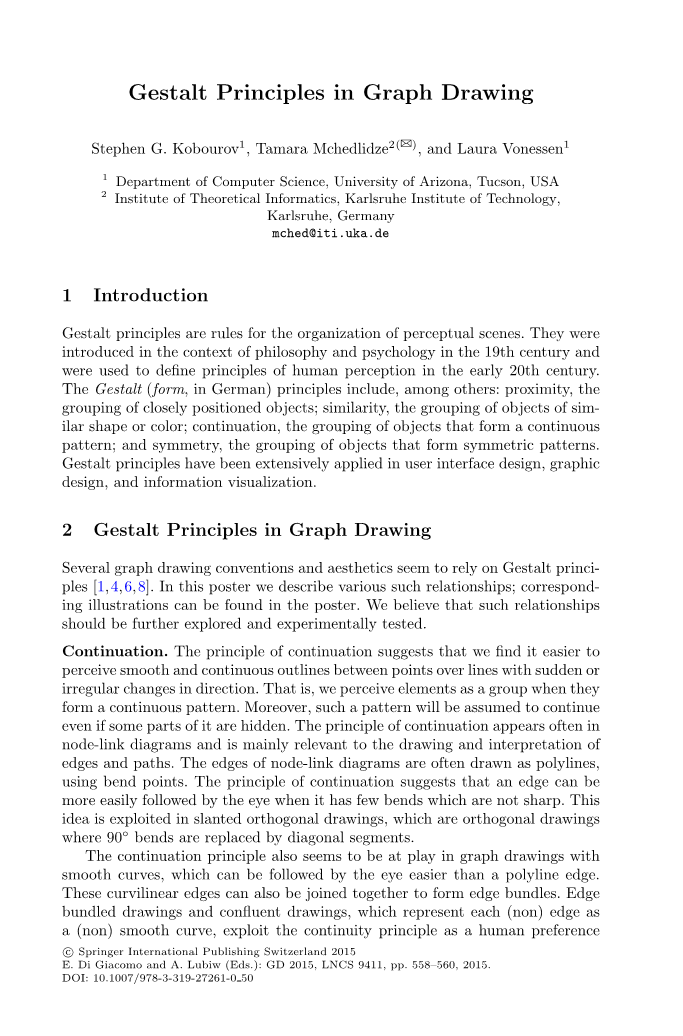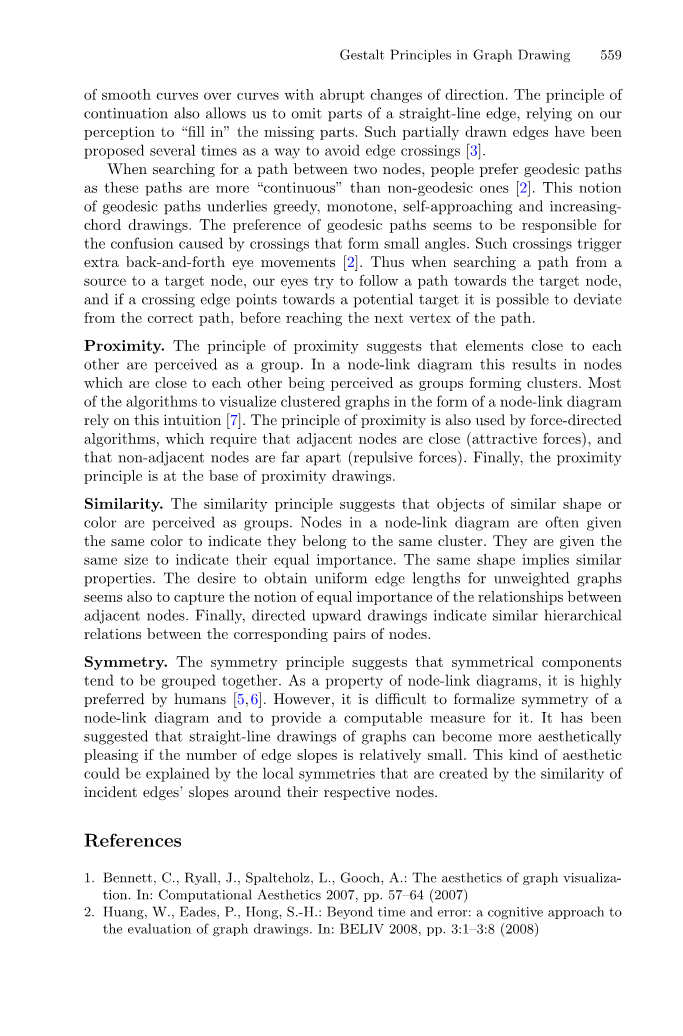

英语原文共 3 页,剩余内容已隐藏,支付完成后下载完整资料
Gestalt Principles in Graph Drawing
Stephen G. Kobourov1, Tamara Mchedlidze2(B), and Laura Vonessen1
1 Department of Computer Science, University of Arizona, Tucson, USA
2 Institute of Theoretical Informatics, Karlsruhe Institute of Technology,
Karlsruhe, Germany
mched@iti.uka.de
1 Introduction
Gestalt principles are rules for the organization of perceptual scenes. They were introduced in the context of philosophy and psychology in the 19th century and were used to define principles of human perception in the early 20th century.
The Gestalt (form, in German) principles include, among others: proximity, the grouping of closely positioned objects; similarity, the grouping of objects of similar shape or color; continuation, the grouping of objects that form a continuous pattern; and symmetry, the grouping of objects that form symmetric patterns. Gestalt principles have been extensively applied in user interface design, graphic design, and information visualization.
2 Gestalt Principles in Graph Drawing
Several graph drawing conventions and aesthetics seem to rely on Gestalt principles [1,4,6,8]. In this poster we describe various such relationships; corresponding illustrations can be found in the poster. We believe that such relationships should be further explored and experimentally tested.
Continuation. The principle of continuation suggests that we find it easier to perceive smooth and continuous outlines between points over lines with sudden or irregular changes in direction. That is, we perceive elements as a group when they form a continuous pattern. Moreover, such a pattern will be assumed to continue even if some parts of it are hidden. The principle of continuation appears often in node-link diagrams and is mainly relevant to the drawing and interpretation of edges and paths. The edges of node-link diagrams are often drawn as polylines, using bend points. The principle of continuation suggests that an edge can bemore easily followed by the eye when it has few bends which are not sharp. This idea is exploited in slanted orthogonal drawings, which are orthogonal drawings where 90◦ bends are replaced by diagonal segments. The continuation principle also seems to be at play in graph drawings with smooth curves, which can be followed by the eye easier than a polyline edge. These curvilinear edges can also be joined together to form edge bundles. Edge bundled drawings and confluent drawings, which represent each (non) edge as a (non) smooth curve, exploit the continuity principle as a human preference
of smooth curves over curves with abrupt changes of direction. The principle of continuation also allows us to omit parts of a straight-line edge, relying on our perception to fill in the missing parts. Such partially drawn edges have been proposed several times as a way to avoid edge crossings [3]. When searching for a path between two nodes, people prefer geodesic paths as these paths are more continuous than non-geodesic ones [2]. This notion of geodesic paths underlies greedy, monotone, self-approaching and increasingchord drawings. The preference of geodesic paths seems to be responsible for the confusion caused by crossings that form small angles. Such crossings trigger extra back-and-forth eye movements [2]. Thus when searching a path from a source to a target node, our eyes try to follow a path towards the target node, and if a crossing edge points towards a potential target it is possible to deviate from the correct path, before reaching the next vertex of the path.
Proximity. The principle of proximity suggests that elements close to each other are perceived as a group. In a node-link diagram this results in nodeswhich are close to each other being perceived as groups forming clusters. Most of the algorithms to visualize clustered graphs in the form of a node-link diagram rely on this intuition [7]. The principle of proximity is also used by force-directed algorithms, which require that adjacent nodes are close (attractive forces), and that non-adjacent nodes are far apart (repulsive forces). Finally, the proximity principle is at the base of proximity drawings.
Similarity. The similarity principle suggests that objects of similar shape or color are perceived as groups. Nodes in a node-link diagram are often given the same color to indicate they belong to the same cluster. They are given the same size to indicate their equal importance. The same shape implies similar properties. The desire to obtain uniform edge lengths for unweighted graphs seems also to capture the notion of equal importance of the relationships between adjacent nodes. Finally, directed upward drawings indicate similar hierarchical relations between the corresponding pairs of nodes.
Symmetry. The symmetry principle suggests that symmetrical components tend to be grouped together. As a property of node-link diagrams, it is highly preferred by humans [5,6]. However, it is difficult to formalize symmetry of a node-link diagram and to provide a computable measure for it. It has been suggested that straight-line drawings of graphs can become more aesthetically pleasing if the number of edge slopes is relatively small. This kind of aesthetic could be explained by the local symmetries that are created by the similarity of incident edgesrsquo; slopes around their respective nodes.
References
1. Bennett, C., Ryall, J., Spalteholz, L., Gooch, A.: The aesthetics of graph visualization. In: Computational Aesthetics 2007, pp. 57–64 (2007)
2. Huang, W., Eades, P., Hong, S.-H.: Beyond time and error: a cognitive approach to the evaluation of graph drawings. In: BELIV 2008, pp. 3:1–3:8 (2008)560 S.G. Kobourov et al.
3. Rusu, A., Fabian, A., Jianu, R., Rusu,
剩余内容已隐藏,支付完成后下载完整资料
资料编号:[239222],资料为PDF文档或Word文档,PDF文档可免费转换为Word


